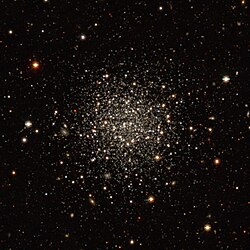Astronomy:NGC 7492
Coordinates: ![]() 23h 08m 26.7s, −15° 36′ 39″
23h 08m 26.7s, −15° 36′ 39″
| NGC 7492 | |
|---|---|
 NGC 7492 with legacy surveys | |
| Observation data (J2000 epoch) | |
| Constellation | Aquarius |
| Right ascension | 23h 08m 26.7s[1] |
| Declination | −15° 36′ 39″[1] |
| Distance | 24,500 kpc (80,000×103 ly)[2] |
| Apparent magnitude (V) | 11.2 |
| Apparent dimensions (V) | 4.2′ |
| Physical characteristics | |
| Absolute magnitude | 0.38±0.04[3] |
| Metallicity | = -1.69[4] dex |
| Estimated age | 12 Gyr[2] |
| Other designations | GCl 125, MWSC 3705 |
NGC 7492 is a globular cluster[1] in the constellation Aquarius. It was discovered by the astronomer William Herschel on September 20, 1786.[5] It resides in the outskirts of the Milky Way, about 80,000 light-years away, more than twice the distance between the Sun and the center of the galaxy, and is a benchmark member of the outer galactic halo.[6] The cluster is immersed in, but does not kinematically belong to, the Sagittarius Stream.[7]
NGC 7492 possess a tidal tail 3.5 degrees long,[8] embedded into an over-density of stars which may be the remnants of a disrupted dwarf galaxy.[9] The shape of the cluster is flattened rather than spherical, likely due to dynamical interaction with the Milky Way.[10]
References
- ↑ 1.0 1.1 1.2 "NGC 7492". SIMBAD. Centre de données astronomiques de Strasbourg. http://simbad.u-strasbg.fr/simbad/sim-basic?Ident=NGC+7492.
- ↑ 2.0 2.1 Ultraviolet Imaging Telescope (UVIT) observation of the Galactic Globular Cluster NGC 7492
- ↑ Variable stars in the globular cluster NGC 7492, New discoveries and physical parameter determination
- ↑ ULTRAVIOLET PROPERTIES OF GALACTIC GLOBULAR CLUSTERS WITH GALEX. II. INTEGRATED COLORS
- ↑ Seligman, Courtney. "New General Catalogue objects: NGC 7450 - 7499". http://cseligman.com/text/atlas/ngc74a.htm#7492. Retrieved 2021-10-02.
- ↑ Koch, Andreas; Xu, Siyi; Rich, R. Michael (2019), "Chemical composition of the outer halo globular cluster Palomar 15", Astronomy & Astrophysics 627: A70, doi:10.1051/0004-6361/201935467, Bibcode: 2019A&A...627A..70K
- ↑ The globular cluster NGC 7492 and the Sagittarius tidal stream: together but unmixed
- ↑
- ↑ Sollima, A.; Martínez Delgado, D.; Muñoz, R. R.; Carballo-Bello, J. A.; Valls-Gabaud, D.; Grebel, E. K.; Santana, F. A.; Côté, P. et al. (2018), "A survey for dwarf galaxy remnants around 14 globular clusters in the outer halo", Monthly Notices of the Royal Astronomical Society 476 (4): 4814–4829, doi:10.1093/mnras/sty539
- ↑ MASS SEGREGATION AND TIDAL TAILS OF THE GLOBULAR CLUSTER NGC 7492
 |

